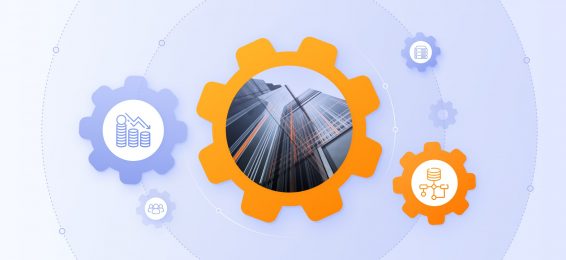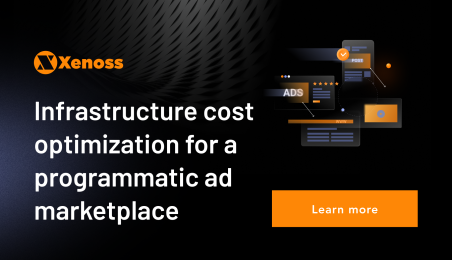The last few years came to foreshadow many important changes for AdTech. The deprecation of ad IDs has advertisers struggling to get closer to their ICPs and publishers looking for ways to leverage their first-party data.
On top of that, the global recession made brands more watchful of the way they allocate budgets and choose AdTech partners. In this landscape, few vendors can feel safe: Most realize the need to reinvent the wheel and scramble for ways to deliver more value.
To thrive in a saturated market, AdTech companies often consider app modernization: Updating and transforming legacy applications to stay in touch with new technologies and approaches.
Although it is not a silver bullet, app modernization brings a lasting positive impact to AdTech projects. Keeping the infrastructure nimble helps improve scalability and brings cost efficiency.
Examining the tech stack and substituting suboptimal tools with those used as an industry standard accelerates time-to-market.
App modernization efforts also improve a platform’s compatibility with other tools, allowing AdTech platforms to fit into the publisher’s or advertiser’s stack.
According to IBM, platforms prioritizing app modernization see a 15-35% infrastructure cost reduction and a 14% revenue boost. Red Hat states that most teams – 54%, according to the company’s research – are planning to update their platforms.
It’s about time that AdTech vendors jump on the bandwagon, especially in a market where innovation is a matter not of choice but survival.
In our experience, AdTech platforms often prioritize building features that can help generate revenue. While profitability is essential, we have often seen the value of a 360-degree view of the IT infrastructure.
Taking a step back from pushing the bottom line and reexamining the infrastructure, tech stack, and IT processes can help companies significantly speed up release timelines for all future features.
Thus, while app modernization might not seem as lucrative as releasing a new feature that can help differentiation, its impact can impact all facets of the organization and generate more revenue in the long run.
In this guide, we will outline the tell-tale signs of legacy apps, zoom in on the long-term benefits of modernization, and examine the application modernization strategy AdTech vendors rely on to revamp their solutions successfully.
Key tech challenges AdTech platforms face
AdTech platforms need to operate within tight constraints. Engineering teams need to balance the expectations for high-speed data processing, the pressure to process multiple data types, and the importance of filtering that data to make correct bidding or targeting calls.
Let’s take a closer look at the key focus areas of AdTech platform performance: speed, data volume, and data quality.
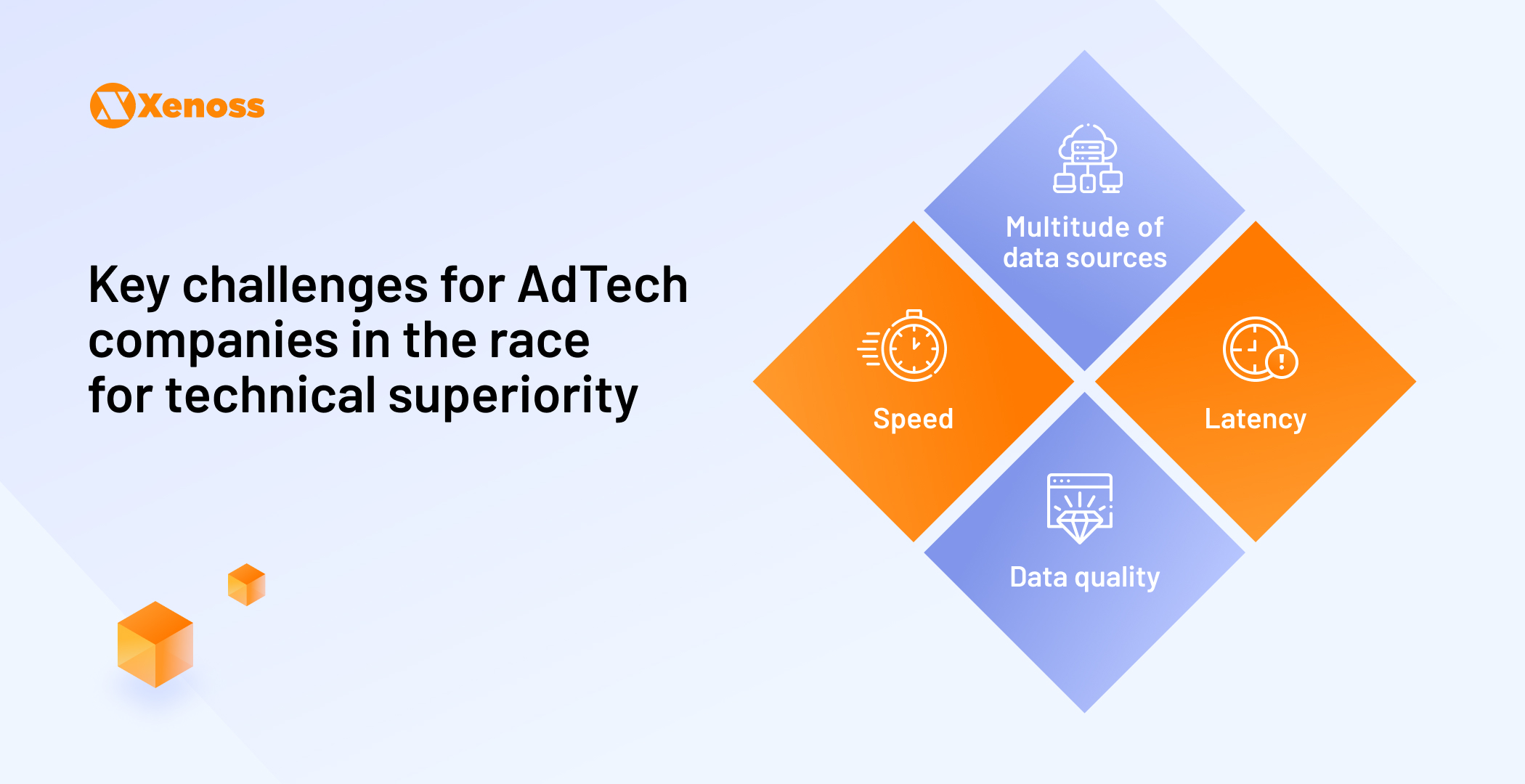
Speed
Ever since RTB revolutionized display advertising in the 2010s, response speed has become a key differentiator between viable and non-viable solutions.
According to Wayne Bloodwell, the CEO of TPA Digital, there are 950 billion programmatic impressions available for buying per day. To process that much data, AdTech engineering teams need to keep a sharp focus on improving technology performance.
There are different ways to accommodate the hard-and-fast nature of the market. When it comes to data storage, practices like partitioning (dividing data by usage patterns or other criteria and keeping older or less used data on cold storage) help improve scalability and cost efficiency.
Right-sizing the size of Kubernetes clusters also helps maintain high performance. Choosing a database attuned to the needs of real-time data processing is also an important piece of the puzzle.
For example, to accommodate its multi-million QPS processing needs, The Trade Desk, Integral Ad Science, and Beeswax use Aerospike, a real-time database tailor-made for the needs of advertising.
Latency
Slow-loading ads have always been a pain for publishers, who end up losing monetization opportunities. To counter the challenge, many are reviewing their AdTech stacks, preferring partners with a toolset for reducing latency.
AdTech platforms have different ways to avoid network congestion. Some use algorithms that help compute a traffic path with the lowest latency, others build distributed systems across multiple locations to reduce response time.
Machine learning models (particularly those dealing with real-time predictions) also tend to increase latency significantly. While a precise machine learning model can improve targeting or enable smart bidding, it puts AdTech vendors at risk of higher latency.
Thus, engineering teams should optimize each model to make sure it operates within the market’s speed limits.
Such optimization is inevitably a trade-off. In discussions with clients, Xenoss engineers regularly emphasize that a latency reduction will lead to lower predictive effectiveness, so it’s important to balance these metrics.
Data quality
As platforms scale and data volumes increase, inspecting the quality of each value gets challenging. Data from different sources might also have inconsistent taxonomies, making it harder to consolidate inputs.
Tech teams need to implement automated quality control algorithms that would detect anomalies in real-time, enabling an uninterrupted flow of high-quality data.
To help their partners organize, clean, and govern datasets, AdTech vendors strengthen their offerings with data analytics capabilities. For instance, Magnite has partnered with Anodot, a machine-learning-based business intelligence platform, to control data quality and instantly spot errors.
Multitude of data sources
Advertising IDs used to enable a reliable stream of data that advertisers could leverage in their campaigns. As they face deprecation, AdTech players are forced to overcome data scarcity by integrating with multiple third-party sources, which requires more efficient integrations and advanced analytics capabilities for connecting available data points.
The need for more data, bid filtering, accurate audience segmentation, and timely bid response pushes AdTech vendors to continue reinforcing their offerings. For those who fail to catch up, chances of survival in the AdTech Wild West are slim.
Survival of the fittest: AdTech companies evolve or fade out
AdTech is a fast-paced industry for every player involved. Just like advertisers need to look for ways to improve the efficiency of their campaigns and publishers need to figure out ways to effectively collect and manage first-party data, AdTech vendors have to continuously adapt their platforms to changing industry trends, the development of emerging channels (CTV and DOOH, among others), and regulatory policies.
The importance of app modernization in the sector becomes all the more clear if you look at former AdTech leaders who faded into oblivion due to a slow rate of change and subpar technology.
Here are a few relics from the ecosystem graveyard that prove the importance of app modernization.
Videology
As it was filing for Chapter 11 bankruptcy, Videology played an “ahead of its time” card. According to the company’s official statement, the market the organization found itself in was “not ready for programmatic video advertising.”
It is hard to reduce Videology’s bankruptcy to a single cause, as many factors contributed to its demise.
Google’s decision to pull its video inventory from Videology and sell it exclusively through DoubleClick and BidManager was certainly an important one.
However, part of VIdeology’s downfall can also be chalked up to failed modernization. Even as the video programmatic market was getting more monopolized, Videology could have fought back with new capabilities. It could’ve, for example, offered advertisers more transparency or switched from a managed to a self-service model. Adapting the platform to the market could prolong its longevity and create new revenue opportunities.
AdBrite
In the early 2010s, AdBrite was one of the most popular ad exchanges around, in the company’s own words, “the largest independent ad exchange”. In 2013, it went out of business after struggling to secure a buyer.
In trying to untangle the reasons for the company’s demise, most evidence points to the inability to compete with the constant evolution of the market. The company had no retargeting capabilities available in FBX (Facebook Ad Exchange, still active at the time) and other offerings. It also had to grapple with a quality issue, with a fair share of below-the-fold ads and a pool of unreliable publishers.
MediaMath
The recent bankruptcy of MediaMath, one of the pioneers and torch-bearers in the DSP space, shows how difficult it is for platforms outside of Google’s or The Trade Desk’s league to stay afloat in a strict privacy landscape and the market of tight ad spend.
MediaMath’s struggles have been in the open for a few years prior to the company’s final shutdown: Turned-down acquisitions, and miscalculations over the market segment to bet on (the bet on in-house programmatic departments and the sunset of agencies did not become reality) were the components of the bind the company found itself in.
As the news sank in, discussions over the need for constant differentiation and evolution in AdTech resurfaced. A few largest-scale DSP players might be next to untouchable, but, for the rest of the market, stability is not set in stone, and the need for innovation and constant pivoting is imminent.
Can application modernization help turn projects around?
As we examined the failures of early AdTech leaders, many of them seemed inevitable – the Google-Facebook duopoly could simply not be stopped.
It’s through the stories of vendors who managed to turn the tide by reviewing and improving their technology that the power of digital transformation becomes clear.
OpenX was one of the early AdTech leaders: In 2015, it was the second-largest vendor by the number of ad impressions served. That scalability came with hurdles. A quarter of the company’s workforce was involved in keeping data centers running. Room for growth was limited, as reaching new markets would exacerbate the need for data centers.
How did OpenX solve the problem? The company turned to digital transformation, building a scalable and automatable cloud infrastructure.
Unwilling to settle for a lift-and-shift, OpenX leveraged containerization and auto-scaling, machine learning (AutoML), and artificial intelligence (Google Cloud AI). According to the team, shifting to Google Cloud services helped reach a new level of optimization and cost-efficiency, reducing server and traffic processing costs by 35%.
While digital transformation might not seem powerful enough to resist broad ecosystem shifts, modern and future-proof infrastructure can help AdTech vendors be more flexible and resilient, as well as free up resources that can be redirected to exploring new growth opportunities.
When you need app modernization: key indicators
An old adage goes, “If it ain’t broke, don’t fix it”. It’s understandable why AdTech vendors, who can’t compromise stability and uptime, would want to take that advice and keep their solutions as they are as long as everything is running smoothly.
At the same time, all too often AdTech vendors realize the need for modernization only when partners prefer more flexible and innovative solutions.
To make sure you can start app modernization before its absence negatively impacts revenue, consider a few common-sense indicators that it’s time to update the product’s architecture and tech stack.
Following our experience of working with all types of AdTech platforms, Xenoss engineers identified the red flags that signal an urgent need for modernization.
1. Worsening of unit economics
Calculating the total cost of ownership (TCO) for your application and measuring it against the business value of the project is an excellent way to determine the need for modernization.
TCO considers both direct (servers, hosting and databases, managed services) and indirect (hiring and training engineers, productive time dedicated to app maintenance, compliance updates, etc.) maintenance costs.
To estimate the total cost of ownership for an AdTech application, calculate the expenses in the following areas:
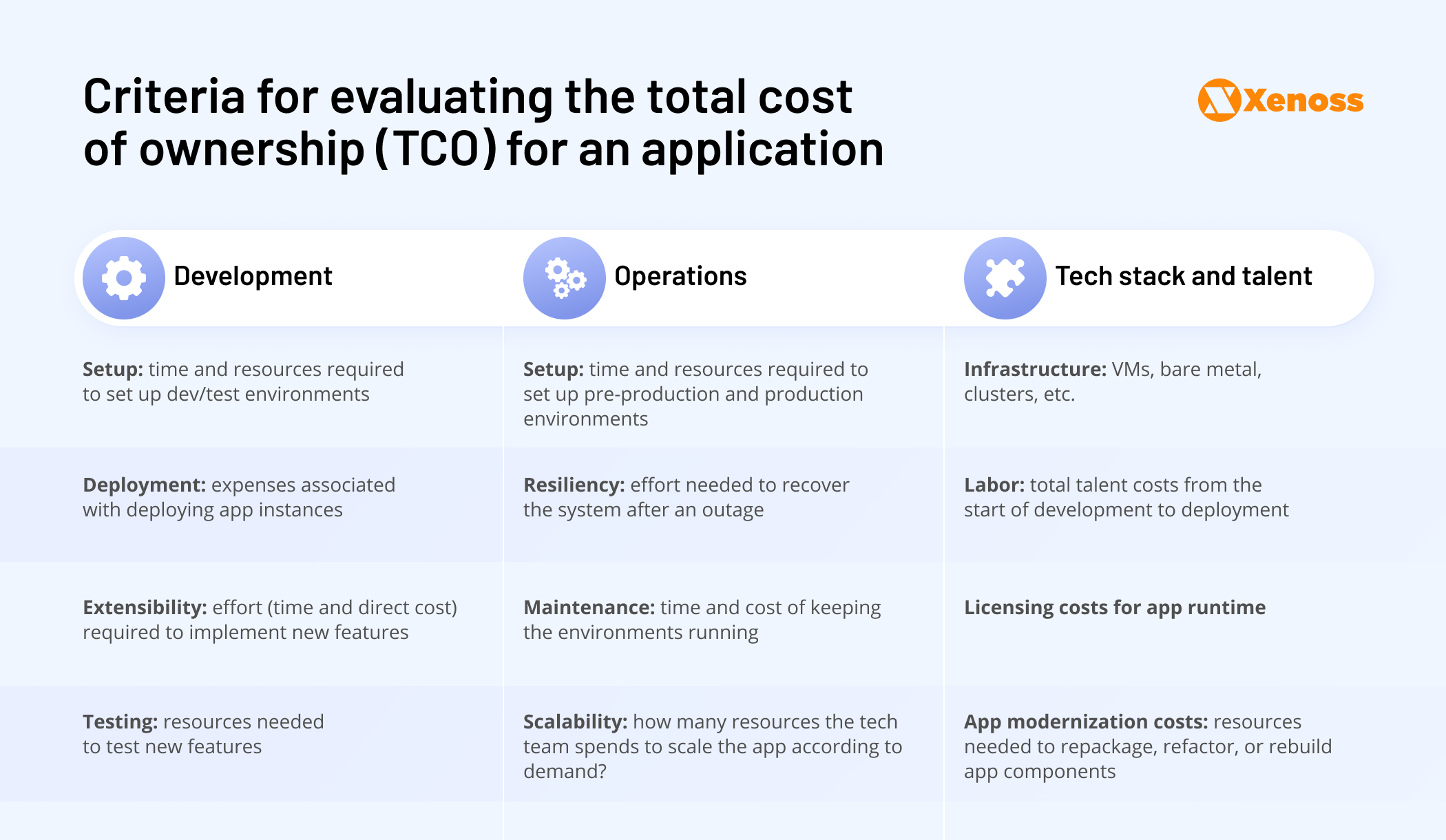
After calculating the cost of ownership for a feature or a project, check how it compares to the revenue generated by the project. If the TCO is higher than the value of the technology, it’s high time to think about app modernization.
2. Slow development due to tech debt
When the technical team fails to meet deadlines regularly, the system itself might be to blame. Early-stage AdTech projects often solve technical problems through point solutions: over time, these one-off fixes tend to accumulate, making it harder to maintain the system as a whole.
Making changes to such fragile systems is much like playing a game of Jenga – taking one block out of the system can push the entire structure to collapse. That’s why, in legacy projects, development teams need to carefully consider every change, which inevitably slows down product delivery.
A thorough app modernization is a reliable solution to the problem – the tech team needs to unravel the spaghetti of point solutions and replace it with a purposeful, modular, and easy-to-control architecture.
3. Dependence on key employees
Legacy code makes it harder to bring new developers into the project. For one, it’s challenging to find engineers for a product that uses old technologies because few people are learning them.
Furthermore, legacy codebases are frequently large and inefficient, with little documentation to facilitate the onboarding of new engineers.
As it’s hard for legacy projects to hire and retain tech talent, their success is heavily reliant on the core team. With that come business risks – as Murphy’s Law would have it, key knowledge holders can leave at the worst possible time, taking the stability of the system down with them.
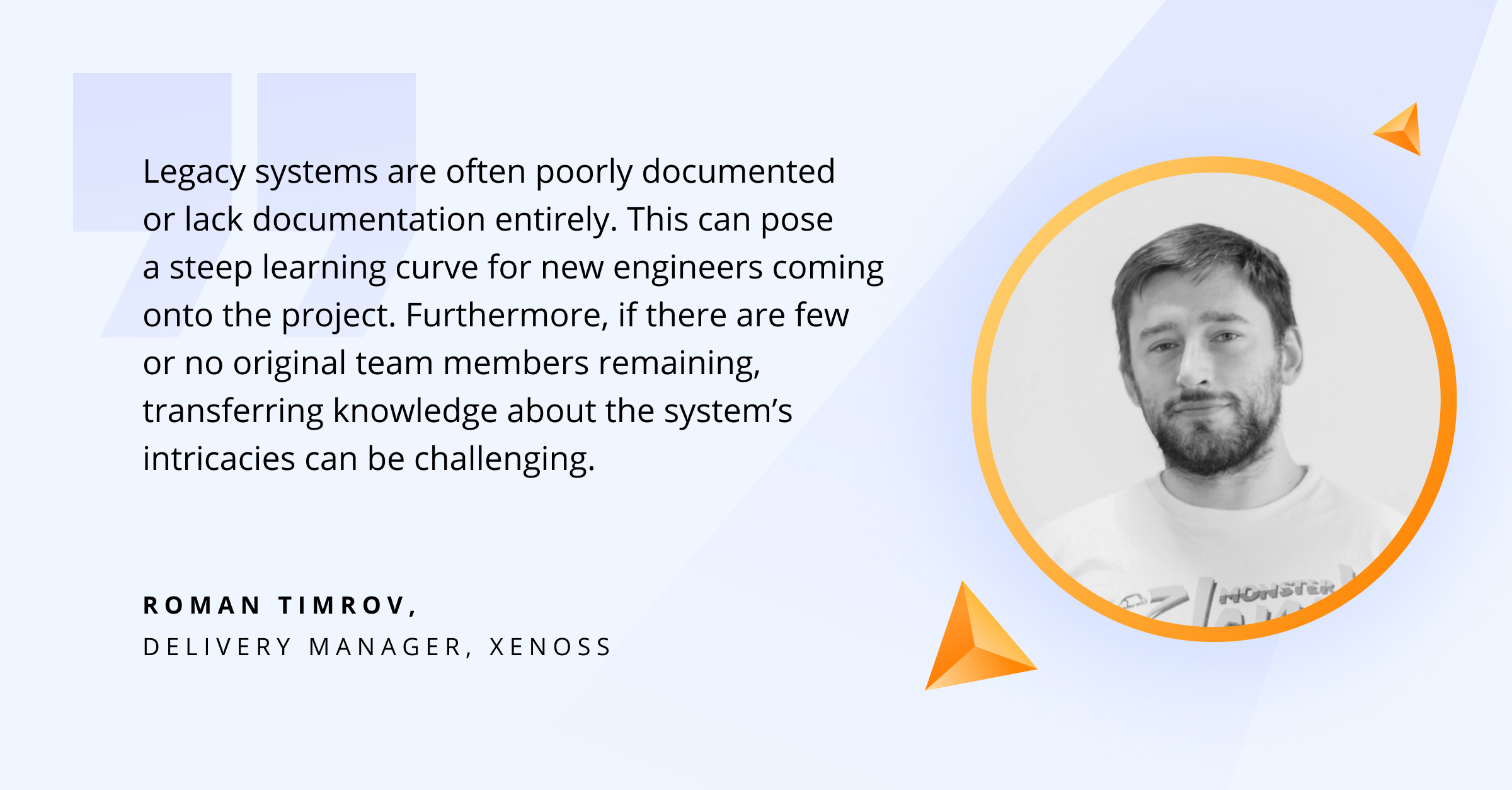
4. Poor data processing capabilities
As more advertisers and publishers embrace programmatic, the volume that passes through SSPs, ad exchanges, and DSPs is growing by the day.
The expectations from advertisers and publishers are high as well. Brands expect to be able to bid on more ads, and media expect to listen in on more bids and maximize their revenue.
As a result, the capacity to process millions of queries per second is a fundamental criterion in vendor selection. Failing to accommodate higher volumes due to poor optimization and architecture that is not designed with scalability in mind will put projects at risk of falling behind more technically advanced competitors.
The inability to withstand progressively increasing data loads should become an immediate driver for app modernization.
5. Poor data processing and activation capabilities
As more advertisers and publishers embrace programmatic, the volume that passes through SSPs, ad exchanges, and DSPs is growing by the day.
The expectations from advertisers and publishers are high as well. Brands expect to be able to bid on more ads, and media expect to receive more bids and maximize their revenue.
As a result, the capacity to process millions of queries per second is a fundamental criterion in vendor selection. Failing to accommodate higher volumes due to poor optimization and architecture that is not designed with scalability in mind will put projects at risk of falling behind more technically advanced competitors.
The inability to withstand progressively increasing data loads should become an immediate driver for app modernization.
The growth of incoming data volumes is another trigger for app modernization.
Once the project accumulates data, whether intentionally (e.g., a publisher maximizing first-party capabilities) or as a byproduct of growth, the tech team might find itself short on tools for data management and activation.
Different types of data can help enhance existing features or lay the foundation for new capabilities. The lack of tools for analyzing, organizing, and leveraging inputs from different sources should be a catalyst for reviewing the tech behind the project and strengthening your data toolset through app modernization.
6. Inability to scale
It is common for AdTech projects to start out with smaller data volumes and scale as they go. In some cases, initial tech architectures struggle to support product growth. Over time, most companies hit scalability hurdles as they lack resources, have high operating costs or a fragmented environment due to the accumulation of point solutions.
App modernization allows tech teams to re-evaluate their architectures and tools. Outdated, ineffective, or expensive solutions can be substituted by flexible and affordable solutions that enable scalability and growth.
To learn more about ways to optimize cost-intensive infrastructures, explore our article on infrastructure cost optimization. We covered common scalability mistakes AdTech companies make, as well as low-cost and low-effort solutions that can help optimize your tech for growth.
7. Suboptimal tech stack
It’s common and necessary for AdTech teams to prioritize time-to-market when choosing the programming language for their project. However, as platforms grow and evolve, scalability and performance become the engineering team’s first priority. As companies scale, they tend to “outgrow” their tech stacks, creating a need for more flexible and versatile tools. New security regulations, an increase in types and data volumes to analyze, or the release of new features can all be catalysts for updating your tech stack.
Another common scenario is when a tech team chooses a programming language that was popular at the time of the release. Yet, as time went by, the technology might have failed to deliver on its promise, or it turned out not to be the right fit for the AdTech domain.
In all of these cases, app modernization, with a review and shift of the codebase to a more versatile and scale-friendly toolset, should become a priority. At Xenoss, we believe that building tech-agnostic solutions to eliminate vendor lock-in is a way to improve the flexibility of AdTech projects. This way of thinking allows engineering teams to replace cloud vendors or software tools without needing to rebuild the application.
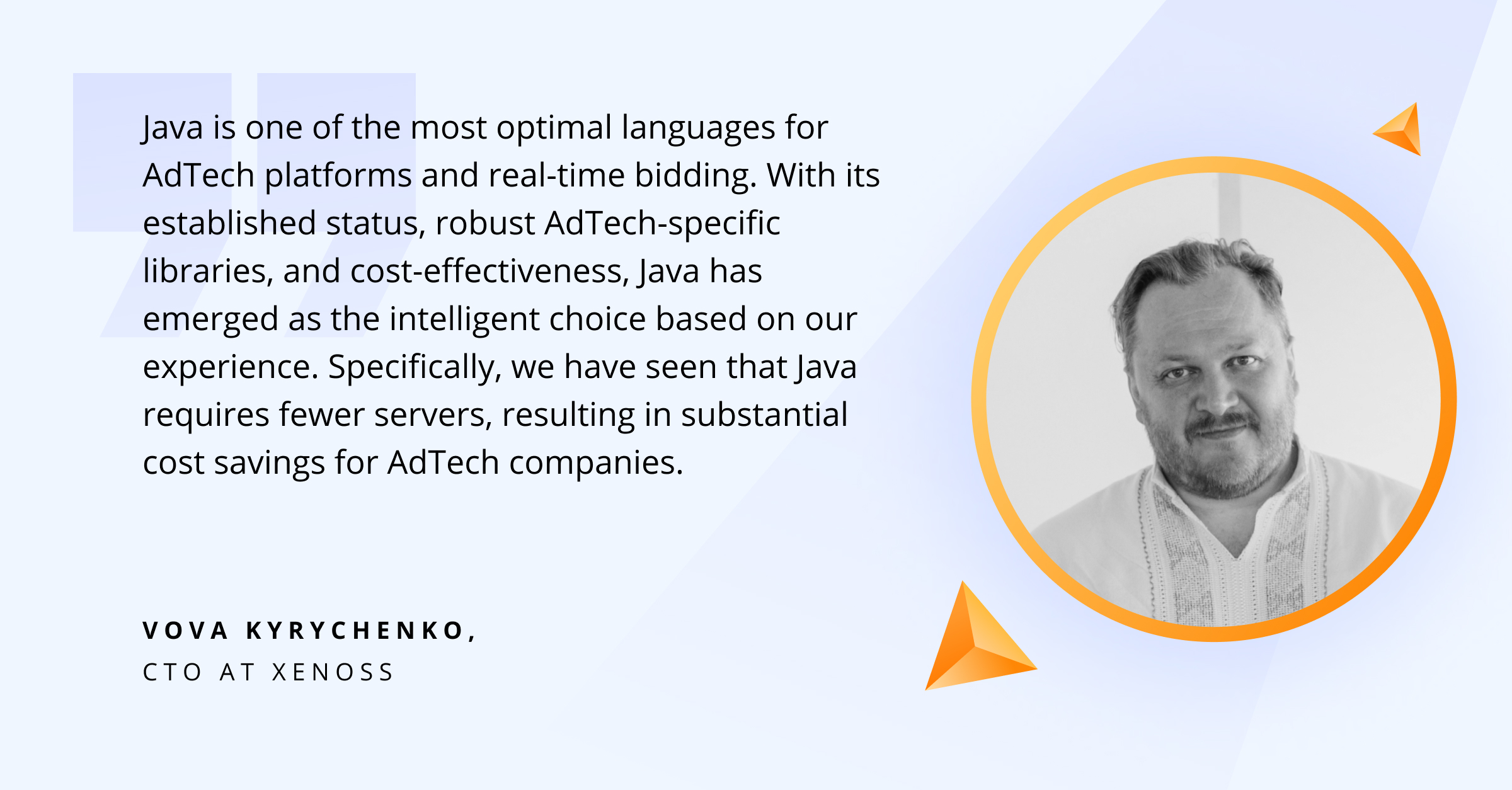
8. Limited ability to integrate with other platforms
Integrations are the core of AdTech offerings. Publishers and advertisers want to be able to move data between tools, shift campaigns between channels, and have a single view of ongoing campaigns.
To meet these expectations, vendors have to be able to integrate quickly with other ecosystem players. Legacy platforms are limited in their ability to do that – because they use rare technologies, require a lot of custom coding to integrate with a third-party data source, or were not designed with integrations in mind.
These systems should be reviewed and modernized to stay competitive in the increasingly interconnected AdTech market.
Widely used app modernization strategies
When it comes to AdTech companies, no two vendors are alike in their stacks. Business objectives, target user segments, team size, and budget are the unique building blocks of a vendor’s tech DNA. As a result, organizations vary in application modernization approaches, with some optimizing what they have and others building new solutions from scratch and retiring old platforms.
The most eloquent summary of app modernization strategy is the 7R methodology.
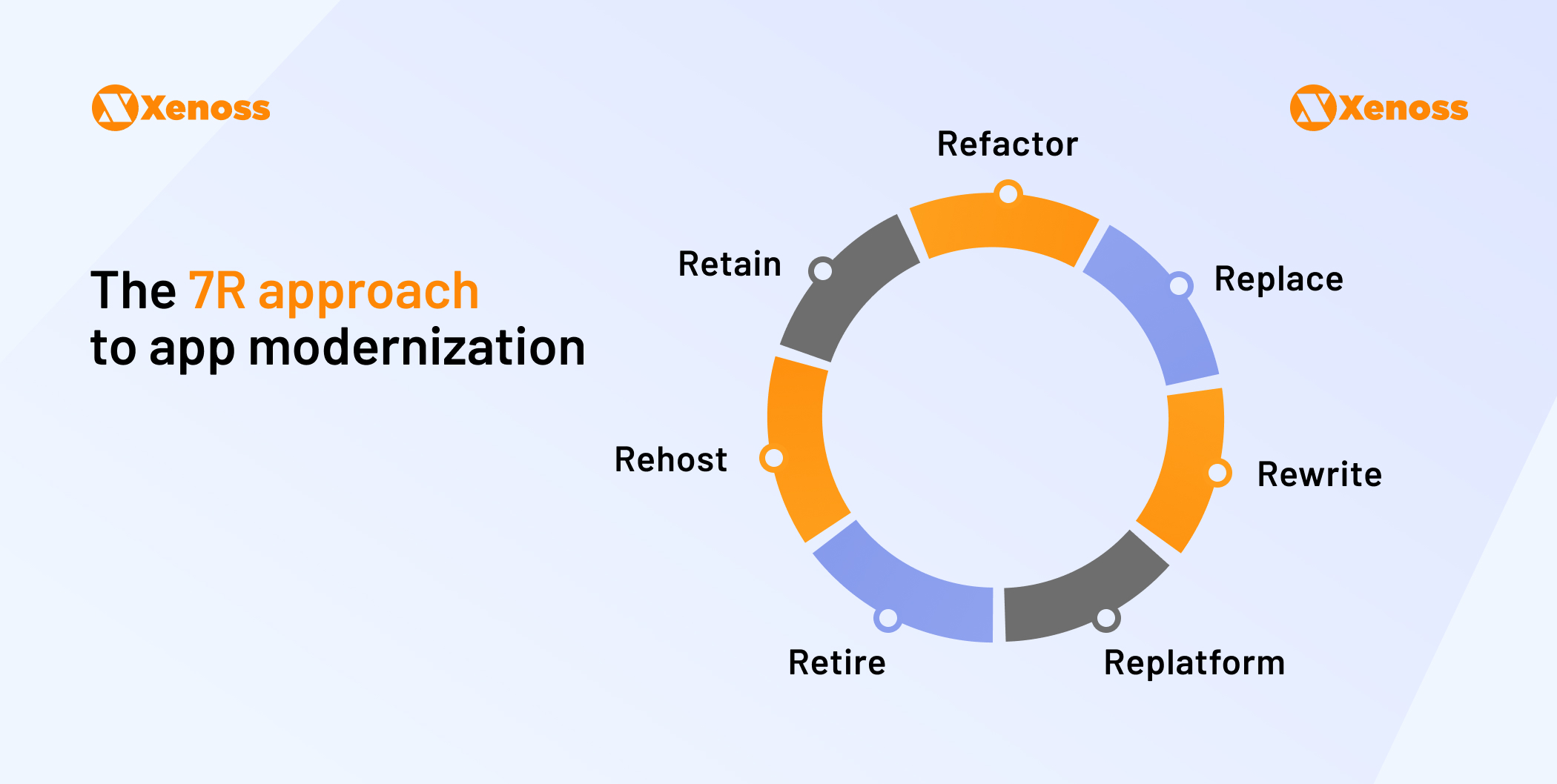
All of these approaches are valid but depend on the context in which the organization finds itself. An infrastructure cost optimization challenge can be solved through rehosting, re-platforming, and refactoring. However, when functionality is missing, the codebase is obsolete, rewriting or rebuilding the product is in order.
Xenoss engineering team worked with a wide range of AdTech modernization scenarios and experienced firsthand the importance of choosing a case-by-case approach to planning.
In an application modernization case study for an in-game advertising platform facing scalability and data integration challenges, we recommended retiring the old product in favor of a new solution.
With another client, we opted for refactoring and cloud migration, helping the team cut infrastructure costs by 20 times.
Tech practices to support application modernization
From building a new solution to ramping up operations to re-platforming the existing infrastructure, there are many approaches to app modernization. They are possible because of a plethora of innovative technologies engineering teams have at their disposal.
In our experience, here are the key tech practices AdTech teams use to modernize their products.
Cloud migration
In the last 5 years, the cloud has been taking tech by storm: According to the State of Cloud 2022 by Pluralsight, 75% report working on cloud-based solutions. The trend is also true for AdTech, with major vendors switching to cloud-based infrastructure: GroupM, PubMatic, The Trade Desk, OpenX, and many more. Migration has many benefits, including higher geographical reach, less pressure associated with the need for maintenance, and faster access to resources.
While Google Cloud and Microsoft Azure have respective benefits, AWS seems to be a top-of-the-mind solution for innovative AdTech projects. AWS earned its reputation as a reliable cloud vendor thanks to unmatched computing capabilities that can empower RTB platforms, focus on cost-efficiency with Spot EC2 instances, and a robust toolset for all types of solutions.
Cloud vendors offer a wide range of native solutions, but AdTech teams need to be mindful of the way they use these capabilities. Additional tools developers add to the infrastructure come with extra costs that grow as projects scale, putting teams at risk of bleeding cash. Thus, it only makes sense to use the capabilities vital to the infrastructure.
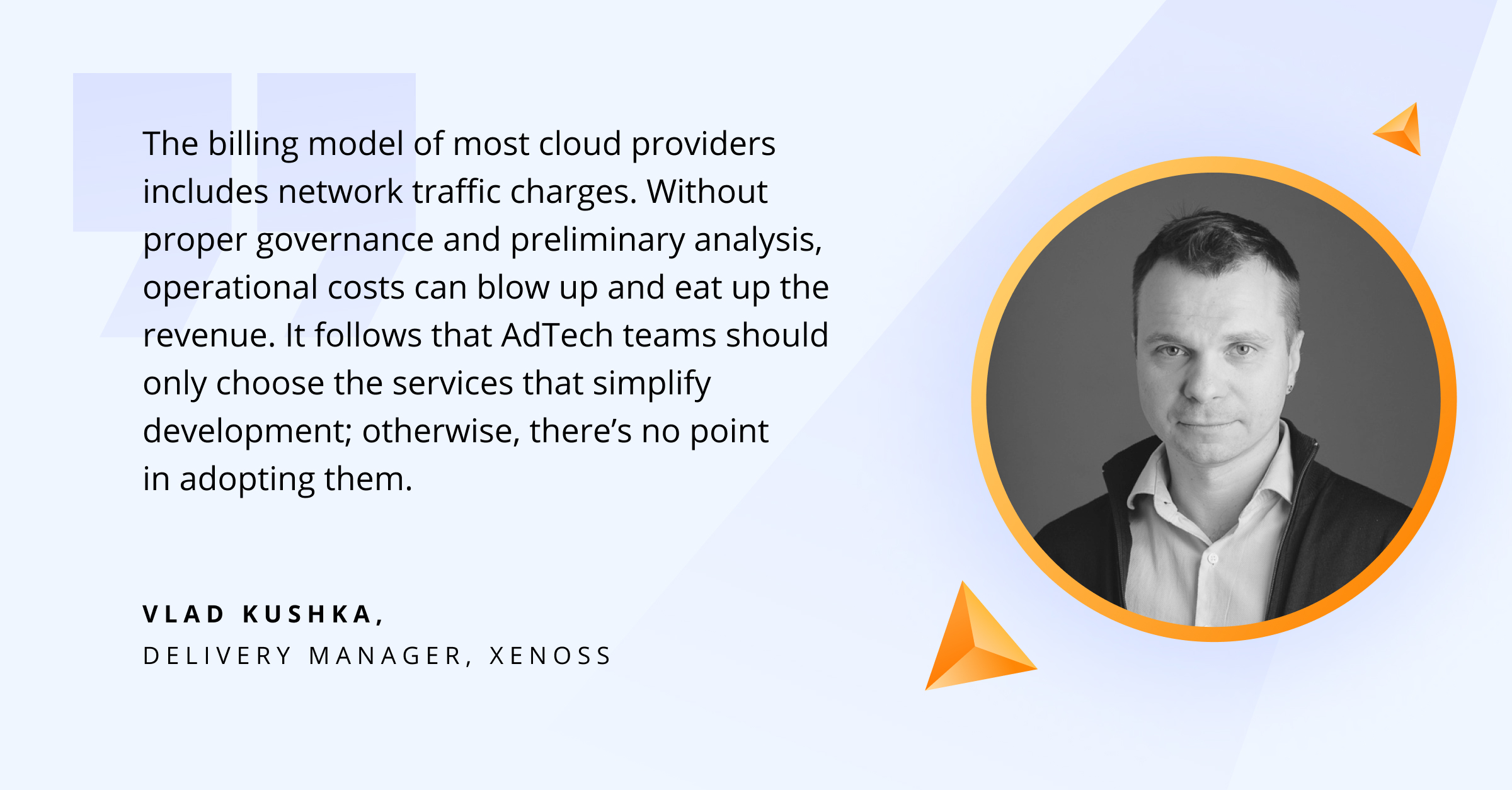
Containerization and microservices
Containerization is a high-yield practice because it improves the portability of the code and eliminates the platform’s reliance on infrastructure vendors. As the name suggests, containerization “wraps” the codebase, associated resources, and libraries in a single package. The application is thus environment-agnostic and capable of running on any device or operating system.
According to Containers in the Enterprise, a survey by IBM, 79% of tech teams see the containerization of internal apps as” important” or “very important”.
The use of Kubernetes has become a gold standard for growth-oriented AdTech applications. AdForm, among others, uses containerization as a way to reduce the amount of resources put into managing virtual machines and leverage the power of the cloud. The platform adopted Kubernetes in 2017, reaping a fivefold infrastructure cost reduction and a 2-3x increase in performance efficiency.
Low-code and no-code development
From an executive’s perspective, app modernization is labor-intensive, requiring the focus of many skilled engineers. From a programmer’s standpoint, modernizing a legacy platform is tedious and monotonous – there are many front-end-to-back-end exchanges.
As a result, tech teams are looking for ways to automate and streamline app modernization. Containerization is one way to go about it – no-code/low-code development is another route.
Breaking a solution into modular no-code/low-code objects reduces time-to-market, facilitates maintenance, and, importantly, enables integrations. Our developers have a proven track record of using pre-built low-code components to build high-performance AdTech platforms under time and budget constraints quickly and saw the efficiency of this approach on many projects.
Building API programs
Leveraging APIs helps AdTech vendors connect both their internal technology and facilitate collaboration with third-party solutions. The benefits are considerable: Expanded functionality, shorter time-to-market, and better use of talent.
Google’s survey of 770 tech leaders at enterprise organizations across North America, Latin America, Europe, and Asia Pacific revealed that mature API users see an 82% increase in efficiency, a 58% improvement in collaboration, and a 55% increase in agility. In the survey, Google defines “maturity” as having a centralized API strategy, an API management platform in place, and a set of practices for administering APIs.
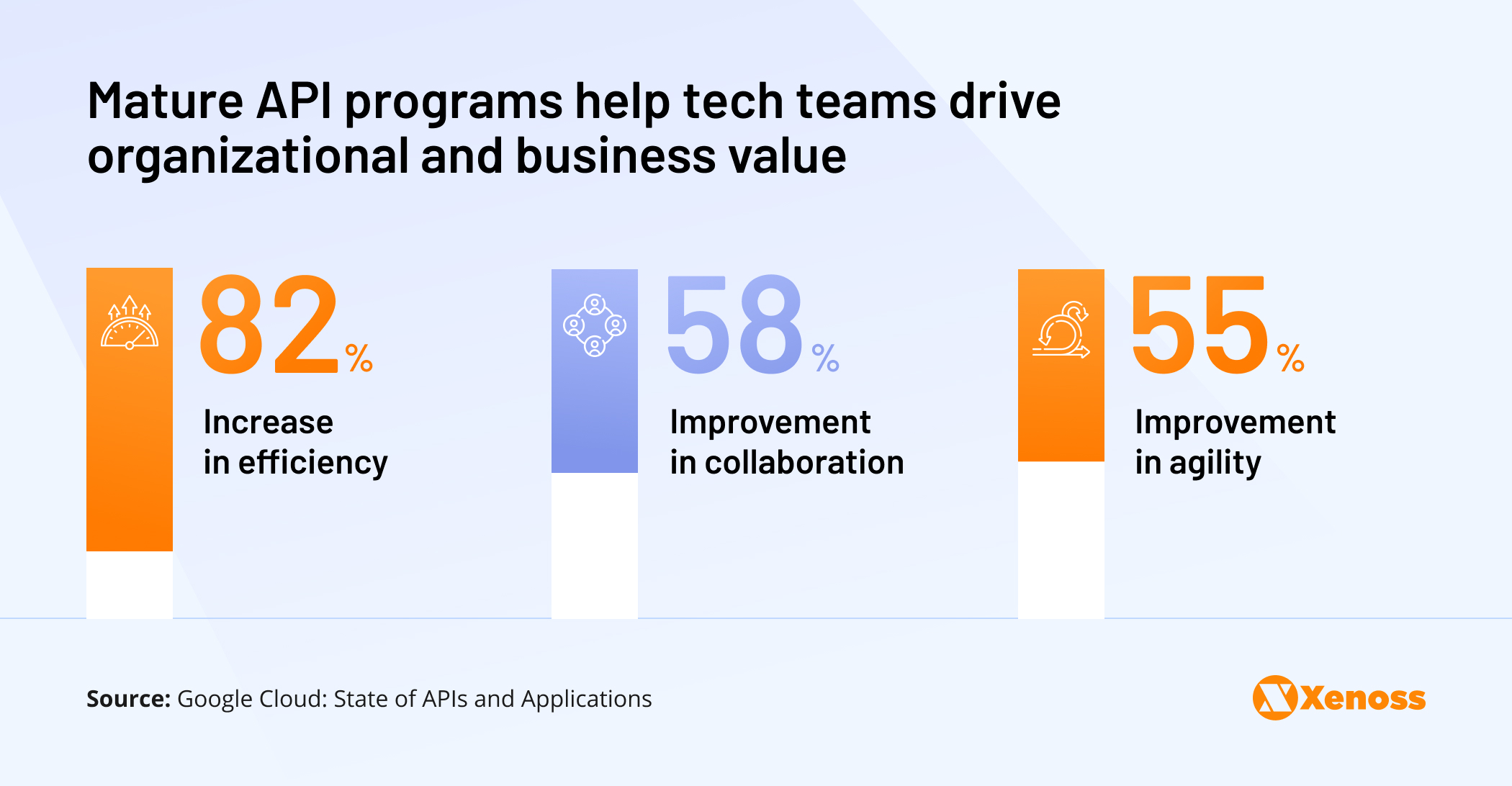
According to the study, only 34% of surveyed tech teams see their API programs as mature.
Among AdTech vendors, industry leaders tend to secure their frontrunner position by developing robust API programs. StackAdapt, for example, released a DSP API that promises to “help any company become an AdTech company” to expand its brand partnerships.
Step-by-step AdTech application modernization strategy
For tech teams considering it, app modernization is a high-risk, high-reward endeavor. If successful, it’s capable of broadening a range of partnerships, cutting maintenance costs, amplifying productivity, and improving user experience.
On the other hand, if it fails to hit the mark, teams are left with wasted budget and time at best and dysfunctional platforms at worst.
How can CTOs, CIOs, and engineering team leaders make sure they are paving the way for app modernization success? Here are the 5 key steps our team follows to build a methodical, organized modernization workflow.
Step 1: Define where you are
Understanding the current state of the organization is essential for creating a successful app modernization strategy. At Xenoss, we recommend that AdTech vendors take a three-fold approach, exploring the state of the organization, the pain points that created the need for modernization, and the objectives of the project.
Let’s take a look at the points that need to be assessed across these areas and questions team leaders should ask to get a full view of their platforms.
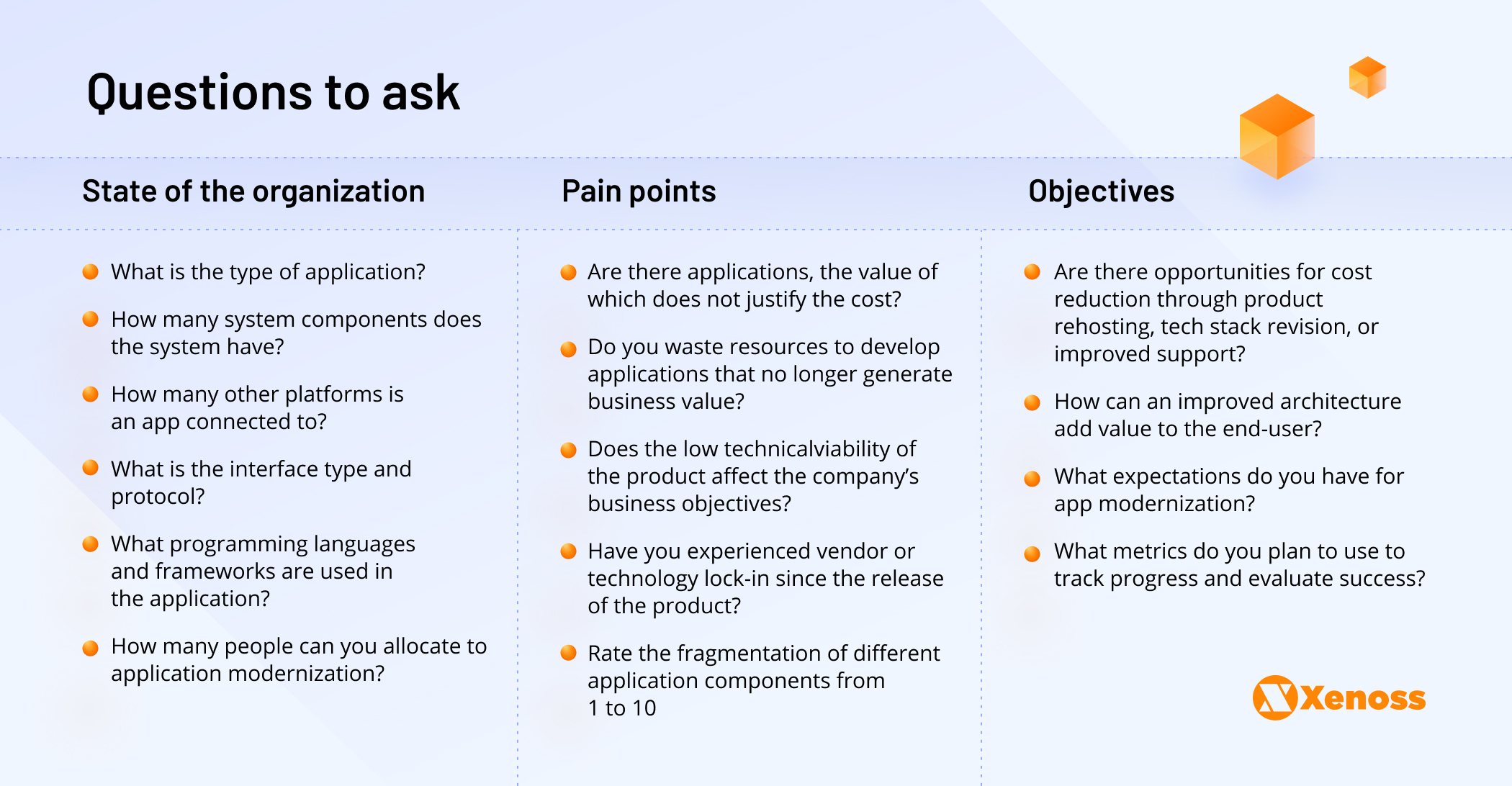
At Xenoss, we often see clients come to us with a business problem without fully understanding its technical root cause. That’s when our tech experts step in and translate a non-tech challenge (“Traffic costs are higher than revenue”) into an engineering problem (“No auction traffic management system”, “Lack of traffic compression”).
These initial assessments help direct app modernization and act with a specific goal in mind.
Step 2: Create an application modernization roadmap
After a thorough assessment of your tech and business processes, as well as a clear understanding of your objectives, it is time to build an actionable app modernization strategy.
A comprehensive app modernization roadmap should cover the steps of the process, timeline, team members involved, budget, and resources required to complete the project.
Here’s a summary of the most important considerations for this stage:
- Extent of modernization: which among the 7Rs the tech team chooses
- Timeline for each phase of app modernization
- Risks and mitigation strategies
- Key milestones for each phase of the project
- Needed resources
- Teammates involved in all stages of the project: coding, testing, project management, etc.
- Budget for each stage
Depending on the extent of the scale of modernization efforts, the number of phases can change. In a flowchart below, we offer one among many ways to structure the timeline.
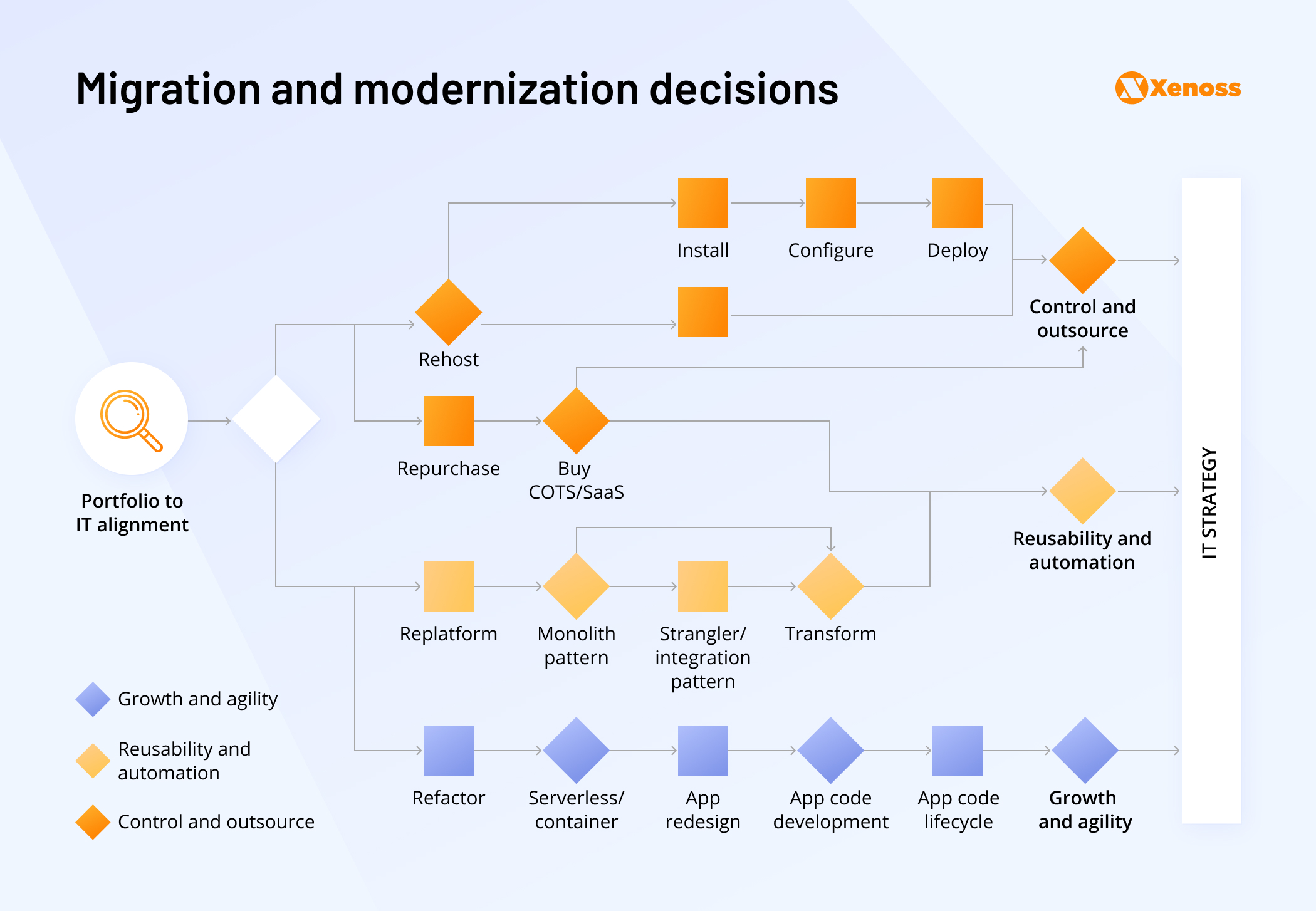
To build an achievable roadmap, it’s helpful to bring in a team of AdTech-specialized engineering experts like Xenoss. Relying on a tech team with an app modernization track record can help AdTech vendors leverage industry standards in budget allocation, talent management, and developing the timeline.
Step 3: Choose the right tools and technologies
With the goal in sight, a clear timeline, and sufficient resources, app modernization teams should build a tech stack that allows them to reach their objectives. As apps modernize, they go through many changes: Programming languages of the codebase, database management systems, or cloud vendors. Understanding which tools fit the platform’s needs is tricky. Here are some of the practices our engineering team uses to choose optimal technology for modernizing AdTech projects:
- Choose managed services wisely: Examine which benefits each service brings to the project and eliminate low-value tools from your tech stack.
- Acknowledge the specific challenges of high-load infrastructures: Realize that the tools you choose to support your AdTech projects might need to readily process high data volumes at high speed. That is typically the case for products supporting RTB.
- Be on the lookout for application modernization best practices: See what the largest ecosystem players are doing and analyze the benefits and drawbacks of their infrastructure decisions. Paying attention to other people’s app modernization journeys will spare you costly mistakes on your own.
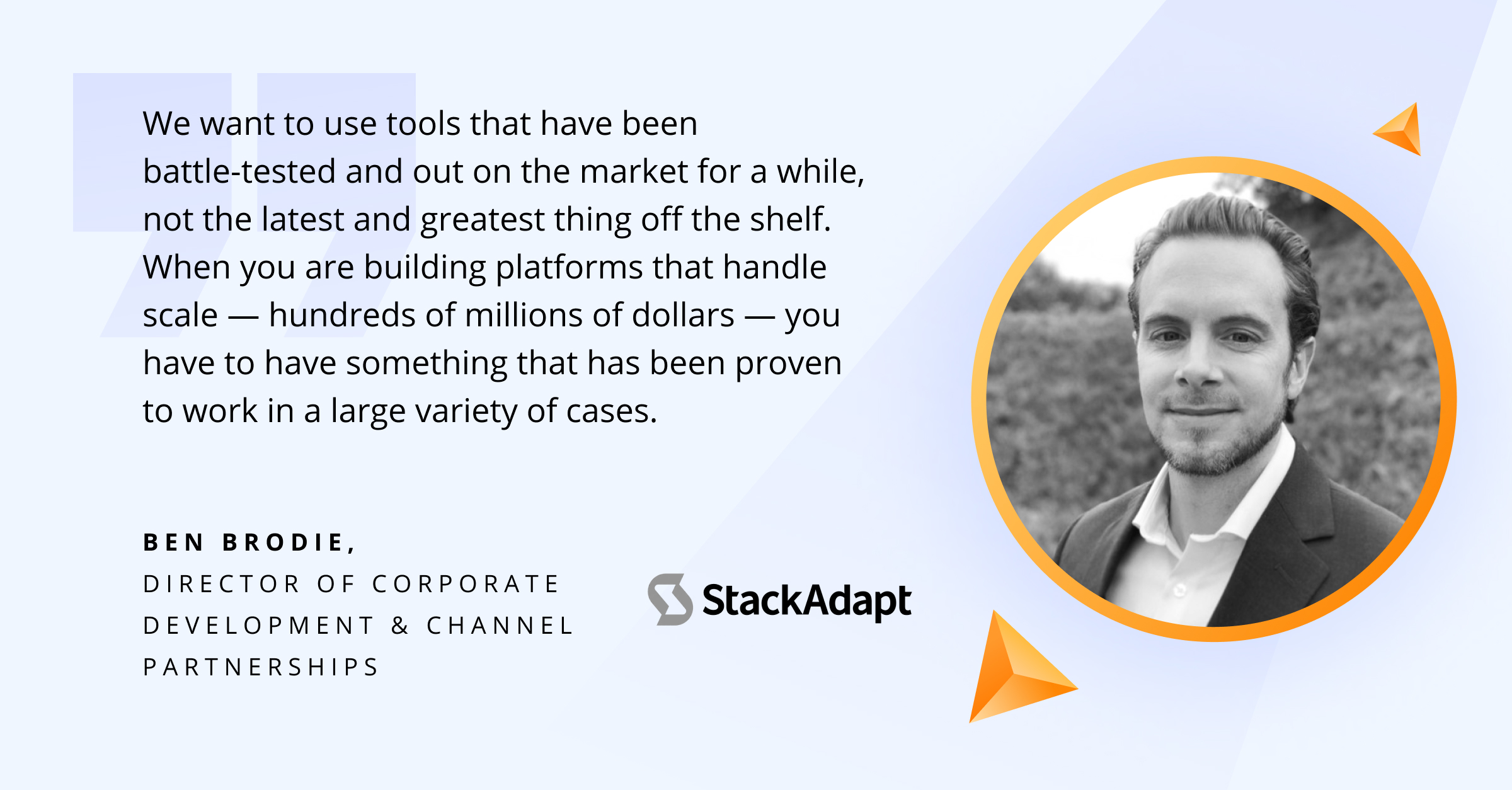
Step 4: Build and test
With the planning out of the way, it’s time to implement the steps of the modernization roadmap. The timeline and list of transformation initiatives vary depending on the type of application and depth of modernization.
Whatever the case may be, we recommend extending application modernization efforts beyond technology itself, putting a lot of focus on improving the tech team and processes. Running regular workshops, assessments, and analyses will help organizations understand the rationale behind decisions and keep all project stakeholders aligned.
Step 5: Continuous improvement
When all changes are deployed and validated in the test environment, it’s time to release the modernized project into production and track its performance. It’s worth noting that the application modernization process is continuous, as tech teams need to adapt to the evolving market.
Assessing the effectiveness of modernization efforts and implementing the takeaways in future iterations is the way for AdTech vendors to stay ahead of the curve. Change management is vital to the success of app modernization, as AdTech vendors need to accurately estimate which capabilities, tools, and skills will be critical moving forward.
Takeaway
App modernization is a powerful way for enterprise AdTech platforms to reduce time-to-market, cut infrastructure costs, improve the performance of their tools, and generate more revenue in the long term.
There are a lot of approaches to app modernization – moving legacy platforms to the cloud, embracing modular infrastructure through containerization, improving interconnectivity through API programs, and others.
Understanding the tools and strategies needed to maximize the performance and operability of an AdTech platform requires both technical and domain knowledge, as well as firsthand experience in enterprise app modernization.
Joining forces with a team of AdTech-focused engineers is one of the ways to access industry know-how and not have to reinvent the wheel.
Xenoss engineering experts, for example, have years of experience in consulting AdTech vendors on app modernization, improving application architectures, and revamping the tech stack to improve performance.
Our application modernization strategies for high-load enterprise platforms cover cloud migration, infrastructure cost optimization, automation, AI and ML implementation, and other ways to expand capabilities and drive business value.
Learn how Xenoss AdTech engineering experts can support your tech team and future-proof your project. Explore Xenoss application modernization services and see how we can help your project.
